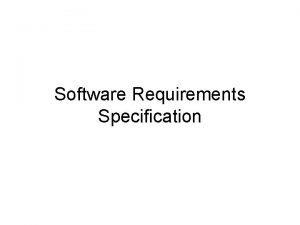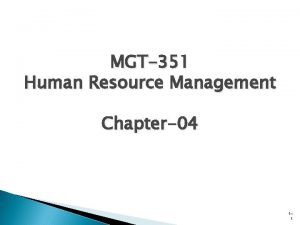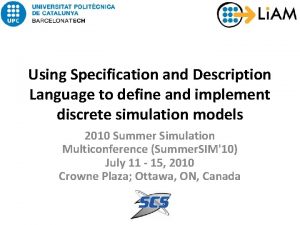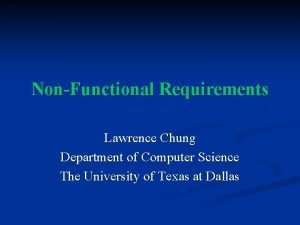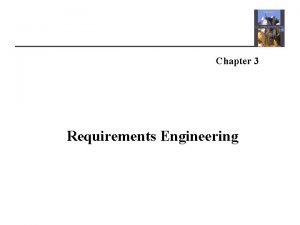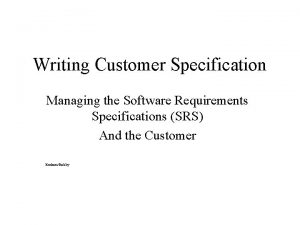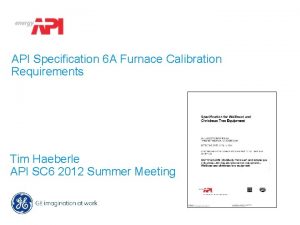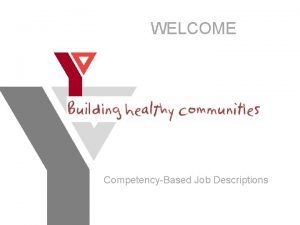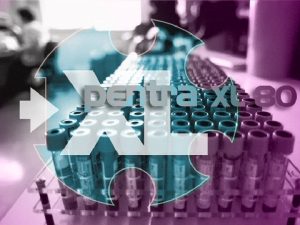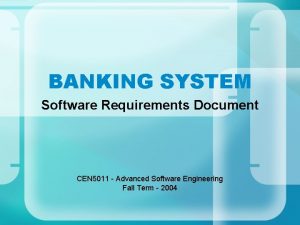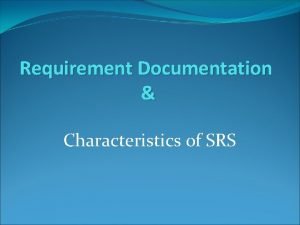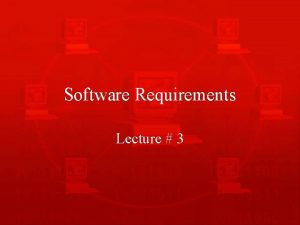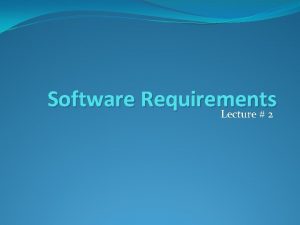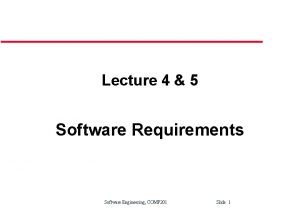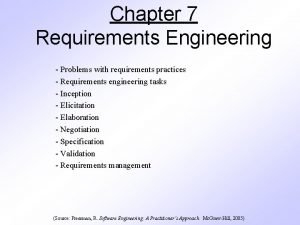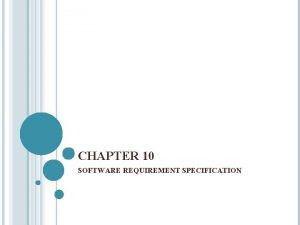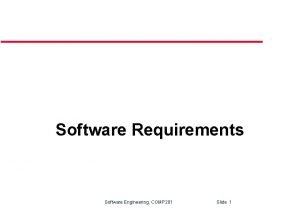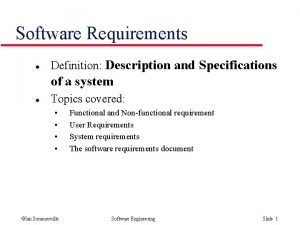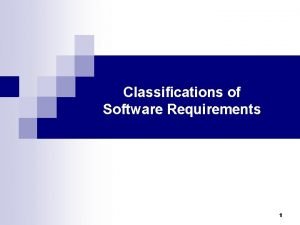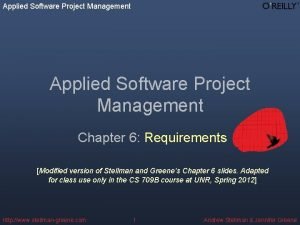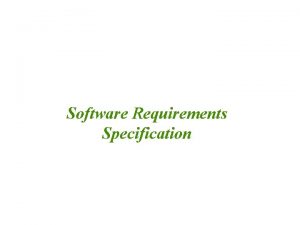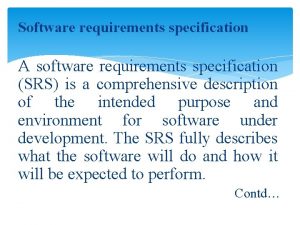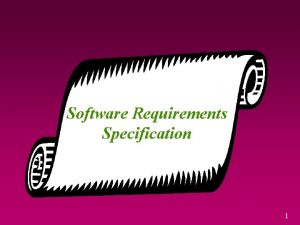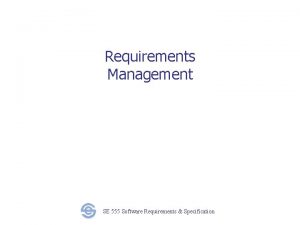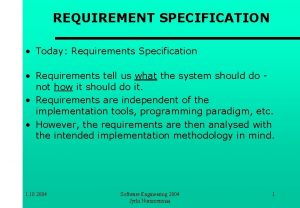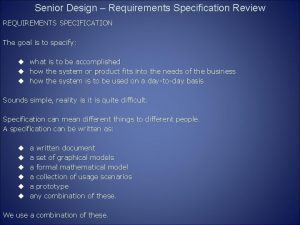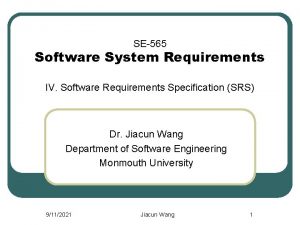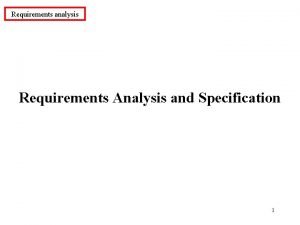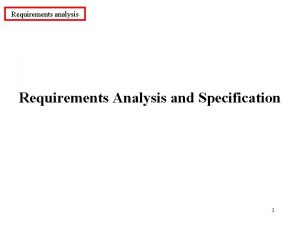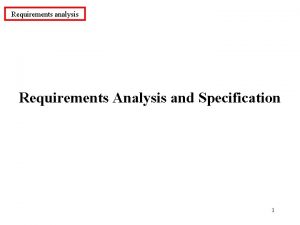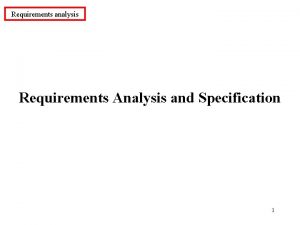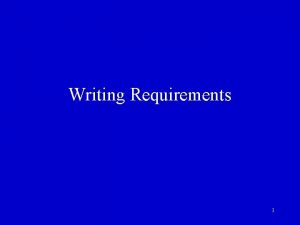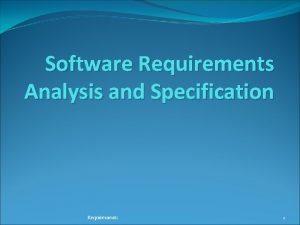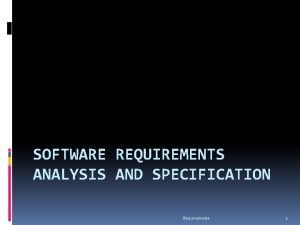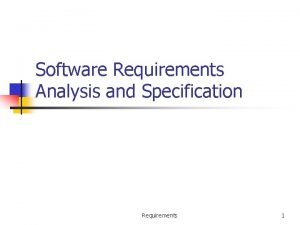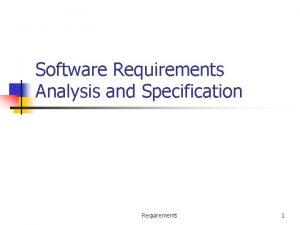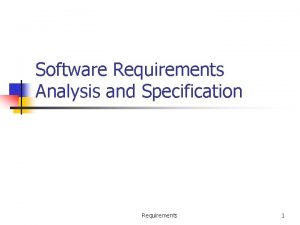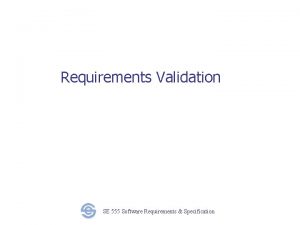Chapter 5 Software Requirements Description and specification of





































- Slides: 37

Chapter 5 Software Requirements: Description and specification of a system ©IS&JCH 050202 Software Engineering Chapter 5 Slide of 45

Objectives l l To introduce the concepts of user and system requirements To describe functional and non-functional requirements To explain two techniques for describing system requirements To explain how software requirements may be organized in a requirements document ©IS&JCH 050202 Software Engineering Chapter 5 Slide 1 of 45

What is a requirement? It may range from a high-level abstract statement of a service or of a system constraint to a detailed specification of mathematical function. It is so because • • It may be used as the basis for a bid for a contract therefore must be open to interpretation, or It may be used as the basis for the contract itself therefore must be defined in detail. ©IS&JCH 050202 Software Engineering Chapter 5 Slide 2 of 45

Requirements definition vs. specification l l Requirements definition: requirements described in the language of problem domain Requirements specification: requirements described in the language of software engineering ©IS&JCH 050202 Software Engineering Chapter 5 Slide 3 of 45

Requirements definition: example The software must provide a means of representing and accessing external files created by other tools. ©IS&JCH 050202 Software Engineering Chapter 5 Slide 4 of 45

Requirements specification: example (continued) l l It should allow the user to define the type of files. It should be able to process every type of file defined. Each file is to be displayed by an icon uniquely associated with its type. It should allow the user to choose the icon associated with each file type. ©IS&JCH 050202 Software Engineering Chapter 5 Slide 5 of 45

Types of requirements l User requirements Statements in natural language plus diagrams of the services the system provides and its operational constraints. Written for customers l System requirements Also known as functional specification, it is a structured document setting out detailed descriptions of the system services. Written as a contract between client and contractor l Software specification A detailed software description which can serve as a basis for a design or implementation. Written for developers ©IS&JCH 050202 Software Engineering Chapter 5 Slide 6 of 45

Various requirements and their intended readers User requirements Client managers Client engineers x x System requirements End users Contractor managers System architect x x Software design requirements ©IS&JCH 050202 Software Engineering Chapter 5 Software developers x x Slide 7 of 45

Functional and non-functional requirements l Functional requirements Statements of services the system should provide, how the system should react to particular inputs and how the system should behave in particular situations. l Non-functional requirements Constraints on the services or functions offered by the system such as timing constraints, constraints on the development process, standards, etc. l Domain requirements Requirements that come from the application domain of the system and that reflect characteristics of that domain ©IS&JCH 050202 Software Engineering Chapter 5 Slide 8 of 45

Functional requirements l l Describe functionality or system services, depending on the type of software, expected users, and the type of system where the software is used. Functional user requirements may be high-level statements of what the system should do whereas functional system requirements should describe the system services in detail. ©IS&JCH 050202 Software Engineering Chapter 5 Slide 9 of 45

Examples of functional requirements l l l The user shall be able to search either all of the initial set of databases or select a subset from it. The system shall provide appropriate viewers for the user to read documents in the document store. Every order shall be allocated a unique identifier, which the user shall be able to copy to the account’s permanent storage area. ©IS&JCH 050202 Software Engineering Chapter 5 Slide 10 of 45

Requirements completeness and consistency l In principle requirements should be both complete and consistent Complete They should include descriptions of all facilities required l Consistent There should be no conflicts or contradictions in the descriptions of the system facilities l In practice, it is impossible to produce a complete and consistent requirements document. ©IS&JCH 050202 Software Engineering Chapter 5 Slide 12 of 45

Non-functional requirements l l l Define system properties and constraints, e. g. reliability, response time and storage requirements. Constraints are I/O device capability, system representations, etc. Process requirements may also be specified mandating a particular CASE system, programming language or development method Non-functional requirements may be more critical than functional requirements. If these are not met, the system is useless ©IS&JCH 050202 Software Engineering Chapter 5 Slide 13 of 45

Examples of non-functional requirements l Product requirements Requirements which specify that the delivered product must behave in a particular way e. g. execution speed, reliability, etc. l Organizational requirements Requirements which are a consequence of organizational policies and procedures e. g. process standards used, implementation requirements, etc. l External requirements Requirements which arise from factors which are external to the system and its development process e. g. interoperability requirements, legislative requirements, etc. ©IS&JCH 050202 Software Engineering Chapter 5 Slide 14 of 45

Non-functional requirement types ©IS&JCH 050202 Software Engineering Chapter 5 Slide 15 of 45

Non-functional requirements examples l Product requirement 4. C. 8 It shall be possible for all necessary communication between the APSE and the user to be expressed in the standard Ada character set l Organizational requirement 9. 3. 2 The system development process and deliverable documents shall conform to the process and deliverables defined in XYZCo-SPSTAN-95 l External requirement 7. 6. 5 The system shall not disclose any personal information about customers apart from their name and reference number to the operators of the system ©IS&JCH 050202 Software Engineering Chapter 5 Slide 16 of 45

Metrics for non-functional req. ©IS&JCH 050202 Software Engineering Chapter 5 Slide 19 of 45

Domain requirements problems l Understandability • • l Requirements are expressed in the language of the application domain This is often not understood by software engineers developing the system Implicitness • Domain specialists understand the area so well that they do not think of making the domain requirements explicit ©IS&JCH 050202 Software Engineering Chapter 5 Slide 24 of 45

User requirements l l Should describe functional and non-functional requirements so that they are understandable by system users who don’t have detailed technical knowledge User requirements are defined using natural language, tables and diagrams ©IS&JCH 050202 Software Engineering Chapter 5 Slide 25 of 45

Guidelines for writing requirements l l Invent a standard format and use it for all requirements. Use language in a consistent way. Use shall for mandatory requirements, and should for desirable requirements. Use text highlighting to identify key parts of the requirement. Avoid the use of computer jargon. ©IS&JCH 050202 Software Engineering Chapter 5 Slide 26 of 45

System requirements l l More detailed specifications of user requirements Serve as a basis for designing the system May be used as part of the system contract System requirements may be expressed using system models discussed in Chapter 7 ©IS&JCH 050202 Software Engineering Chapter 5 Slide 27 of 45

Requirements and design l l In principle, requirements should state what the system should do and the design should describe how it does this. In practice, requirements and design are inseparable • • • A system architecture may be designed to structure the requirements The system may inter-operate with other systems that generate design requirements The use of a specific design may be a domain requirement ©IS&JCH 050202 Software Engineering Chapter 5 Slide 28 of 45

Problems with natural-language specification l Ambiguity The readers and writers of the requirement must interpret the same words in the same way. NL is naturally ambiguous so this is very difficult l Over-flexibility The same thing may be said in a number of different ways in the specification l Lack of modularization NL structures are inadequate to structure system requirements ©IS&JCH 050202 Software Engineering Chapter 5 Slide 29 of 45

Alternatives to natural language l l Structured natural languages Design description languages Graphical notations Mathematical specifications ©IS&JCH 050202 Software Engineering Chapter 5 Slide 30 of 45

Structured language specifications l l l A limited form of natural language may be used to express requirements This removes some of the problems resulting from ambiguity and flexibility and imposes a degree of uniformity on a specification Often best supported using a forms-based approach ©IS&JCH 050202 Software Engineering Chapter 5 Slide 31 of 45

Form-based specifications l l l Definition of the function or entity Description of inputs and where they come from Description of outputs and where they go to Indication of other entities required Pre and post conditions (if appropriate) The side effects (if any) ©IS&JCH 050202 Software Engineering Chapter 5 Slide 32 of 45

PDL-based requirements definition l l Requirements may be defined operationally using a language like a programming language but with more flexibility of expression Most appropriate in two situations • • l Where an operation is specified as a sequence of actions and the order is important When hardware and software interfaces have to be specified Disadvantages are • • The PDL may not be sufficiently expressive to define domain concepts The specification will be taken as a design rather than a specification ©IS&JCH 050202 Software Engineering Chapter 5 Slide 34 of 45

PDL disadvantages l l l PDL may not be sufficiently expressive to express the system functionality in an understandable way Notation is only understandable to people with programming language knowledge The requirement may be taken as a design specification rather than a model to help understand the system ©IS&JCH 050202 Software Engineering Chapter 5 Slide 36 of 45

Interface specification l l Most systems must operate with other systems and the operating interfaces must be specified as part of the requirements Three types of interface may have to be defined • • • l Procedural interfaces Data structures that are exchanged Data representations Formal notations are an effective technique for interface specification ©IS&JCH 050202 Software Engineering Chapter 5 Slide 37 of 45

PDL interface description interface Print. Server { // defomes am abstract print server // requires: interface Printer, interface Print. Doc // provides: initialize, print, display. Print. Queue, cancel. Print. Job, switch. Printer void initialize (Printer p); void print (Printer p, Print. Doc d); void display. Print. Queue (Printer p); void cancel. Print. Job (Printer p, Print. Doc d); void switch. Printer (Printer p 1, Printer p 2, Print. Doc d); }//Print. Server ©IS&JCH 050202 Software Engineering Chapter 5 Slide 38 of 45

The requirements document l l l The requirements document is the official statement of what is required of the system developers Should include both a definition and a specification of requirements It is NOT a design document. As far as possible, it should state WHAT the system should do rather than HOW it should be done ©IS&JCH 050202 Software Engineering Chapter 5 Slide 39 of 45

Users of a requirements document

Desired properties of a requirements spec. l l l Specify external system behaviour Specify implementation constraints Easy to change Serve as reference tool for maintenance Record forethought about the life cycle of the system, i. e. , predict changes Characterize responses to unexpected events ©IS&JCH 050202 Software Engineering Chapter 5 Slide 41 of 45

IEEE requirements standard l l l Introduction General description Specific requirements Appendices Index This is a generic structure that must be instantiated for specific systems ©IS&JCH 050202 Software Engineering Chapter 5 Slide 42 of 45

Requirements document structure l l l l l Introduction Glossary User requirements definition System architecture System requirements specification System models System evolution Appendices Index ©IS&JCH 050202 Software Engineering Chapter 5 Slide 43 of 45

Key points l l Requirements set out what the system should do and define constraints on its operation and implementation. Functional requirements set out services the system should provide. Non-functional requirements constrain the system being developed or the development process. User requirements are high-level statements of what the system should do. ©IS&JCH 050202 Software Engineering Chapter 5 Slide 44 of 45

Key points (continued) l l l User requirements should be written in a natural language supplemented by tables and diagrams. System requirements are intended to communicate the functions that the system should provide, and may be written in structured natural language, a PDL, or in a formal language. A software requirements document is an agreed statement of the system requirements. ©IS&JCH 050202 Software Engineering Chapter 5 Slide 45 of 45
 Requirement specification
Requirement specification If lclp is negative number, we set the lclp = 0. why?
If lclp is negative number, we set the lclp = 0. why? Natural variations operations management
Natural variations operations management Job description and job specification in hrm
Job description and job specification in hrm Difference between job description and job analysis
Difference between job description and job analysis Sdl specification and description language
Sdl specification and description language Volere requirements specification template
Volere requirements specification template System requirements specification
System requirements specification Customer requirements specification
Customer requirements specification Volere requirements specification template
Volere requirements specification template Sae ams2750
Sae ams2750 Ambulance dispatch system requirements specification
Ambulance dispatch system requirements specification How to develop a competency based job description
How to develop a competency based job description Software requirement analysis and specification
Software requirement analysis and specification Cost analyst
Cost analyst Cost analysis requirements description
Cost analysis requirements description Example of domain requirements
Example of domain requirements Product specification software
Product specification software Software requirement specification for banking system
Software requirement specification for banking system Modifiability in srs is
Modifiability in srs is Srs document
Srs document Out of specification software
Out of specification software Srs document example
Srs document example Hardware and software requirements
Hardware and software requirements Domain requirements
Domain requirements Inverse requirements in software engineering
Inverse requirements in software engineering What is domain requirements in software engineering
What is domain requirements in software engineering Requirements discovery techniques in software engineering
Requirements discovery techniques in software engineering Domain requirements
Domain requirements Should engineering
Should engineering Seven distinct tasks to requirements engineering
Seven distinct tasks to requirements engineering Characteristics of good srs in software engineering
Characteristics of good srs in software engineering User requirements software engineering
User requirements software engineering System requirements in software engineering
System requirements in software engineering Source and sink model
Source and sink model Software requirements types
Software requirements types Applied software project management
Applied software project management Srs prototype outline
Srs prototype outline
